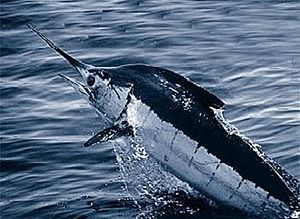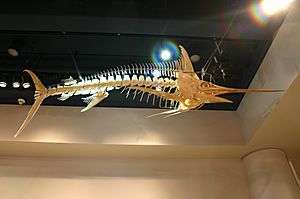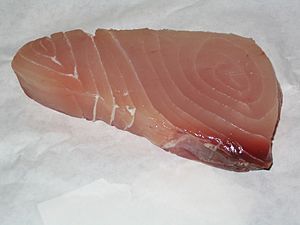Atlantic blue marlin facts for kids
Quick facts for kids Atlantic blue marlin |
|
|---|---|
 |
|
| Male | |
| Conservation status | |
| Scientific classification | |
| Genus: |
Makaira
|
| Species: |
nigricans
|
 |
|
| The range of the Atlantic blue marlin | |
| Synonyms | |
|
See below |
|
The Atlantic blue marlin (scientific name: Makaira nigricans) is a large fish that lives only in the Atlantic Ocean. It's very similar to the blue marlin found in the Pacific and Indian Oceans. Some scientists think they are the same species, while others believe they are different.
This amazing fish hunts many different creatures near the ocean's surface. It uses its long, pointed bill to hit and stun other fish, then comes back to eat them. The blue marlin is a very popular fish for sport fishing. Its meat is also valuable in some places because it has a lot of fat. It is even the national fish of the Commonwealth of The Bahamas and appears on their coat of arms!
Blue marlin live in the warm, tropical parts of the Atlantic Ocean. They are "bluewater" fish, meaning they spend most of their lives far out in the open sea. Female blue marlin can grow much larger than males, sometimes four times heavier! The heaviest blue marlin ever officially recorded weighed about 818 kilograms (1,800 pounds) and was 5 meters (16 feet) long.
People love to catch blue marlin for sport. Commercial fishermen also catch them, sometimes on purpose and sometimes by accident, when they are fishing for tuna. Sadly, blue marlin are considered a threatened species. This is mainly because too many are being caught, especially near Portugal where they go to breed. Some old names for the blue marlin include "Cuban black marlin" and "ocean gar."
Contents
What's in a Name?
The blue marlin belongs to a group of fish called Makaira. This name comes from an old Greek word, machaira, which means "a short sword." The second part of its scientific name, nigricans, is Latin for "becoming black."
The blue marlin is part of the billfish family, called Istiophoridae. It's also in the larger group of fish called perch-like fish (Perciformes). It's a type of bony fish (Osteichthyes), which means it has a skeleton made of bone, not cartilage like sharks.
Scientists are still discussing if the Atlantic blue marlin and the Indo-Pacific blue marlin are truly separate species. Even though they live in different oceans, some studies show they are very similar genetically.
Other Names for the Blue Marlin
Over time, the Atlantic blue marlin has been given many different scientific names. Here are some of them:
- Maikaira nigricans (sic)
- Makaira nigricans nigricans
- Xiphias ensis
- Makaira ensis
- Tetrapturus herschelii
- Histiophorus herschelii
- Makaira herschelii
- Tetrapturus amplus
- Makaira ampla
- Makaira ampla ampla
- Makaira nigricans ampla
- Makaira bermudae
- Orthocraeros bermudae
- Eumakaira nigra
- Makaira nigra
- Makaira perezi
- Istiompax howardi
How to Identify a Blue Marlin

Female blue marlin are much bigger than males. The largest females can be over four times heavier than the largest males. Males usually don't weigh more than 160 kilograms (350 pounds). The longest females can reach 5 meters (16 feet) in length, including their bill. The bill itself makes up about 20% of their total body length.
The heaviest blue marlin ever caught by sport fishing rules weighed 636 kilograms (1,402 pounds). Fishermen often call marlin that weigh 1,000 pounds or more "granders."
Blue marlin have two dorsal fins (on their back) and two anal fins (on their belly). These fins are supported by bony spines. They also have long, narrow pectoral fins on their sides. Their pelvic fins are shorter and can be tucked into grooves on their body. This helps the fish swim faster by making its body more streamlined and reducing drag.
Like other billfish, blue marlin can quickly change their color. This happens because of special cells in their skin.
Most often, their body is dark blue or black on top and silvery white underneath. They have about 15 rows of pale, blue stripes on their sides. The first dorsal fin is dark blue or almost black. Other fins are usually brownish-black.
Their body is covered with thick, bony scales. The bill is long and strong. Both their jaws and the roof of their mouth have small, rough teeth. They have a special "lateral line" system that helps them sense water movements and pressure changes.
Where Do Blue Marlin Live and Travel?
Blue marlin live in the tropical parts of the Atlantic Ocean all year round. During warmer months, they spread out into cooler waters in the north and south. When it gets colder, they move back closer to the Equator. Warm ocean currents, like the Gulf Stream, greatly affect where they are found each season.
They are usually found in waters warmer than 24°C (75°F). However, they have been seen in waters as warm as 30.5°C (86.9°F) and as cool as 21.7°C (71.1°F).
Scientists use special tags to track blue marlin and learn about their journeys. These studies show that marlin travel a lot. They move between the Caribbean Islands, Venezuela, and the Bahamas. Some have even traveled from the Caribbean to West Africa! One amazing journey was by a blue marlin tagged off Delaware, USA, which was later found near Mauritius in the Indian Ocean. That's a trip of over 14,893 kilometers (9,254 miles)!
Who Hunts the Blue Marlin?
Once blue marlin grow up, they don't have many natural enemies. The main predators are killer whales and large sharks like the shortfin mako and great white shark.
Blue marlin can have many tiny creatures living on or inside them, called parasites. These include different types of worms, copepods (tiny crustaceans), and even small barnacles.
Life of a Blue Marlin
Growing Up and Having Babies
Atlantic blue marlin become ready to have babies when they are two to four years old. Males are ready when they weigh about 35-44 kilograms (77-97 pounds). Females are ready when they weigh about 47-61 kilograms (104-134 pounds).
Blue marlin usually breed in late summer and fall. A female can lay eggs up to four times in one season. She can release over seven million tiny eggs at once! Very few of these eggs will grow into adult marlin. The baby marlin, called larvae, float freely in the open ocean. They are found in areas like the western Atlantic, off the Southern United States, Jamaica, The Bahamas, and Brazil.
These tiny larvae can grow very fast, up to 16 millimeters (0.6 inches) in a single day! They are blue-black on top and white underneath. As they grow, their first dorsal fin gets smaller compared to their body size. Male blue marlin can live for about 18 years, while females can live up to 27 years.
What Do Blue Marlin Eat?
Baby blue marlin eat tiny sea creatures called zooplankton, along with other fish eggs and larvae. As they get bigger, they start eating many different kinds of fish, especially mackerel and tuna. They also eat squid and sometimes smaller fish found near islands and coral reefs.
Studies of their stomach contents show that they often eat smaller schooling fish like frigate mackerel and skipjack tuna. Squid and deep-sea fish are also important parts of their diet. Blue marlin have been seen eating prey as large as other marlin and even big tuna weighing 45 kilograms (100 pounds)! But they can also eat many small fish like filefish.
Scientists and fishermen have wondered for a long time how blue marlin use their long bill to hunt. A study in 2007 found that many of the fish in blue marlin stomachs had marks from being speared or slashed by the marlin's bill. This shows they use their bill to injure their prey before eating it.
Mercury in Marlin
Sometimes, harmful substances like heavy metals can build up in blue marlin. This process is called bioaccumulation. Because of this, some health departments, like the Texas Parks and Wildlife Department, have advised people to limit how much blue marlin they eat due to the presence of mercury.
Why Are Blue Marlin Important?
Commercial Fishing
Marlin meat is sold around the world. In 2000, over 3,000 metric tons were caught. It is especially prized in Japan for sashimi, which is thinly sliced raw fish. Blue marlin meat is sometimes smoked and sold by vendors.
Blue marlin are often caught by accident in large fishing operations that use long lines to catch tuna. This is called bycatch.
Sport Fishing
People started fishing for blue marlin for sport in the Bahamas in the 1920s and 1930s. Since then, blue marlin have become known as one of the greatest sport fish in the world. Fishing for marlin and other billfish has grown into a huge business. It supports many companies and jobs for boat operators, boat builders, marinas, and fishing gear makers.
The most popular places to fish for blue marlin are along the eastern coast of the United States, the Gulf Coast, Bermuda, the Bahamas, and several Caribbean islands. People also fish for them in Hawaii, Brazil, Venezuela, and the Atlantic coast of Mexico. In the eastern Atlantic, you can find blue marlin sport fishing off the coast of Portugal and around islands like the Azores, Canaries, and Madeira.
The International Game Fish Association keeps records for the biggest fish caught. The current world record for a blue marlin caught by rod and reel is 636 kilograms (1,402 pounds). This huge fish was caught in Vitoria, Brazil.
Protecting the Blue Marlin
The blue marlin is facing a lot of pressure from longline fishing. For example, in the Caribbean, fishermen from Japan and Cuba catch over a thousand tons each year. In the United States, boats within 320 kilometers (200 miles) of the coast must release any billfish they catch. However, many released fish do not survive because they are injured during the catch.
The Makaira nigricans is listed as a threatened species by the International Union for Conservation of Nature (IUCN). In 2010, Greenpeace International added the blue marlin to its "seafood red list," which means it's a species to avoid eating due to conservation concerns.
Sport fishermen have actually been leaders in trying to protect blue marlin populations. They helped develop electronic tags to track these fast-moving fish. This work started with marlin in Hawaii, with help from anglers in a big fishing tournament.
Blue Marlin in Stories
Famous writers like Zane Grey and Ernest Hemingway loved to fish for blue marlin. Hemingway especially fished for them off the Florida Keys, the Bahamas, and Cuba. He wrote a lot about his experiences.
In Hemingway's famous short novel, The Old Man and the Sea, the main character, an old fisherman named Santiago, battles a giant blue marlin for three days off the coast of Cuba.
See also
 In Spanish: Aguja azul para niños
In Spanish: Aguja azul para niños




